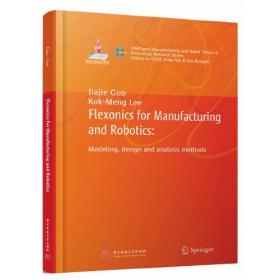
柔性机器人机构建模、设计与制造(英文版)
¥ 31.5 2.5折 ¥ 128 全新
库存20件
河北保定
认证卖家担保交易快速发货售后保障
作者郭家杰;李国民
出版社华中科技大学出版社
出版时间2019-04
版次1
装帧精装
货号9787568040549
上书时间2024-12-28
- 在售商品 暂无
- 平均发货时间 27小时
- 好评率 暂无
- 最新上架
商品详情
- 品相描述:全新
图书标准信息
- 作者 郭家杰;李国民
- 出版社 华中科技大学出版社
- 出版时间 2019-04
- 版次 1
- ISBN 9787568040549
- 定价 128.00元
- 装帧 精装
- 开本 16开
- 纸张 铜版纸
- 页数 176页
- 字数 358千字
- 【内容简介】
- This book formulates the large deformation of a 3-D compliant beam as a boundary value problem (BVP). Unlike other methods, such as finite element (FE) method, that formulate problems based on displacements and/or rotational angles, the BVP formulation has been derived using curvatures that are more fundamental in presenting nonlinear geometries. Since in the case of finite rotation, superposition holds for curvatures but not for rotational angles, the model is much simpler and the resulting computational process is more efficient. The above advantages have been employed in this research to analyze compliant mechanism designs using curvature-based beam models. Along with the method of deriving the compliant members in the same global reference frame, a generalized constraint acting on a compliant mechanism is presented to replace traditional boundary constraints (such as fixed, pinned or sliding constraint) where none or only one degree of freedom (DOF) is allowed. Inspired by the dexterity of a natural biological joint that offers efficient multi-axis rotation, this research extends to the modeling method of a generalized constraint (or referred to here as a bio-joint constraint) to develop designs emulating commonly observed human motions of multi-DOFs . Using a multiple shooting method (MSM), the BVP is treated as an initial value problem and higher order accuracy can be achieved than finite element (FE) methods.
- 【作者简介】
- Jiajie Guo?received the B.S. degree from the Department of Mechanics and Engineering Science at Peking University, Beijing, in 2006, and M.S. and Ph.D. degrees from Mechanical Engineering, Georgia Institute of Technology, Atlanta, in 2009 and 2011, respectively. He is currently an Associate Professor in the State Key Laboratory of Digital Manufacturing and Equipment and the School of Mechanical Science and Engineering at Huazhong University of Science and Technology, Wuhan, China. He is an IEEE and ASME member, and a program committee member of the IEEE/ASME International Conference on Advanced Intelligent Mechatronics. His current research interests include human-centered robotics, flexible mechatronics, manufacturing and system dynamics/control. He has published more than thirty peer-reviewed technical papers in journals and conferences, and has been awarded the best paper award from IEEE/ASME Transactions on Mechatronics in 2015. Kok-Meng Lee?earned his B.S. degree from the University of Buffalo, the State University of New York, Buffalo, NY, USA, in 1980, and S. M. and Ph. D. degrees from Massachusetts Institute of Technology, Cambridge, MA, USA, in 1982 and 1985, respectively. He is currently Professor of Mechanical Engineering at Georgia Institute of Technology, Atlanta, GA, USA. He is also Distinguished Professor with the State Key Laboratory of Digital Manufacturing Equipment and Technology, Huazhong University of Science and Technology, China, under Thousand Talents Plan. Prof. Lee’s research interests include system dynamics/control, robotics, automation, and mechatronics. He is a world renowned researcher with more than 30 years of research experience in magnetic field modeling and design, optimization and implementation of electromagnetic actuators. He has published over 150 peer-reviewed papers and he holds eight patents in machine vision, three degrees of freedom (DOF) spherical motor/encoder, and live-bird handling system. He is IEEE/ASME Fellow and was the Editor-in-Chief for the IEEE/ASME Transactions on Mechatronics from 2008 to 2013. Recognitions of his research contributions include the National Science Foundation (NSF) Presidential Young Investigator, Sigma Xi Junior Faculty Research, International Hall of Fame New Technology, and Kayamori Best Paper awards.?
- 【目录】
-
Acknowledgements/ii
Table of contents/iii
LIST OF TABLES/vi
LIST OF FIGURES/vii
List of SYMBOLS/xi
List of ABBREVIATIONS/xiii
Preface/xv
CHAPTER I Introduction/1
1.1 Background and Motivation/1
1.2 Problem Description and Objectives/1
1.3 Review of Related Work/2
1.3.1 Compliant mechanisms/3
1.3.2 Joint constraint/4
1.3.3 Numerical methods for boundary value
problems/6
1.3.4 Flexible robotics for structural
health monitoring/7
1.3.5 Human-centered equipment
(Exoskeleton)/9
1.3.6 Process state monitoring for
manufacturing/10
1.3.7 Poultry-meat processing/13
1.4 Book Outline/14
CHAPTER II Fundamentals of mathematics/15
2.1 Differential Geometry/15
2.2 Curvature of a 3D Beam/16
2.3 Kinematics of a 3D Beam/18
2.4 Kinematics of an Annular Plate/23
2.5 Multiple Shooting Method/26
2.6 Summary/27
CHAPTER III Flexible Elements/28
3.1 Two-dimensional Beam/28
3.2 Three-dimensional Beam/31
3.3 Annular Plate/38
3.4 General Constraint/44
3.5 Summary/54
CHAPTER IV Flexonic Mobile Node/55
4.1 Design Concept/55
4.1.1 Dimension/56
4.1.2 Attachment/57
4.1.3 Flexibility/57
4.2 Functionalities/59
4.2.1 Sensor attachment/60
4.2.2 Convex corner negotiation (2D)/63
4.2.3 Convex corner negotiation (3D)/66
4.2.4 Concave corner negotiation/69
4.2.5 Environment monitoring/70
4.3 Experimental Validation/74
4.3.1 First prototype of FMN/74
4.3.2 Second prototype of FMN/82
4.4 Structural Health Monitoring/85
4.4.1 Steel frame structure/86
4.4.2 Space frame bridge/88
4.5 Summary/93
CHAPTER V Intelligent Manufacturing/94
5.1 Dynamic Analysis/94
5.1.1 Parametric Effects on |A(ωnm)|
(DC1)/96
5.1.2 Illustrative example (DC1)/97
5.1.3 Numerical Verification (DC1 and
DC2)/99
5.2 Parameter Identification and Sensing
Configuration/101
5.2.1 Modal Damping Coefficients/102
5.2.2 Step Response/104
5.2.3 Robustness of Sensor Performance/105
5.2.4 Sensor Configuration Design/106
5.3 Formulation of Field Reconstruction/108
5.3.1 Field Reconstruction Algorithm/110
5.3.2 Numerical Verification/111
5.3.3 Numerical Evaluation of
Reconstruction Algorithm/113
5.4 Experiment Results and Illustrative
Application/114
5.4.1 Free Vibration of Non-rotating
Plate/115
5.4.2 Field Reconstruction for
Machining/118
5.5 Summary/121
CHAPTER VI Bio-inspired Exoskeleton/122
6.1 Human Knee Kinematics/122
6.2 Knee Joint Dynamics/125
6.3 Knee-exoskeleton Coupling/129
6.3.1 Coupled Kinematics/131
6.3.2 Coupled Dynamics/132
6.4 Experimental Investigation/132
6.4.1 Design Configurations/133
6.4.2 Experimental Test Bed/134
6.4.3 Experimental Methods/135
6.4.4 Results and Discussion/137
6.5 Summary/145
CHAPTER VII Musculoskeleton Modeling/146
7.1 Musculoskeletal System/146
7.1.1 Coordinates/147
7.1.2 Bio-joint Constraint/148
7.1.3 Clavicle Model/150
7.1.4 Soft Tissue Mechanics/154
7.2 Experimental Investigation/155
7.2.1 Elastic modulus of clavicle/155
7.2.2 Ligament mechanics/159
7.3 Illustrative Application to Wing
Manipulation/162
7.4 Summary/165
References/167
Authors/176
点击展开
点击收起
— 没有更多了 —












以下为对购买帮助不大的评价